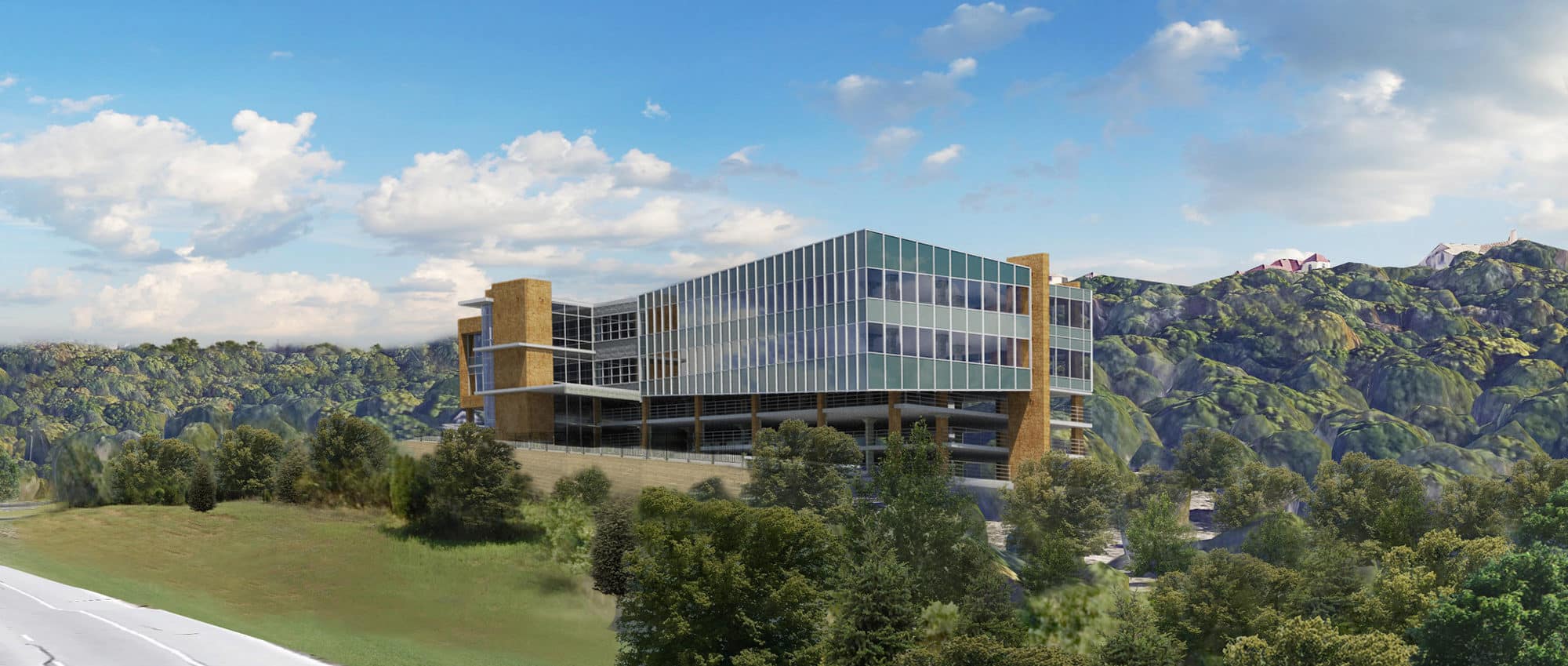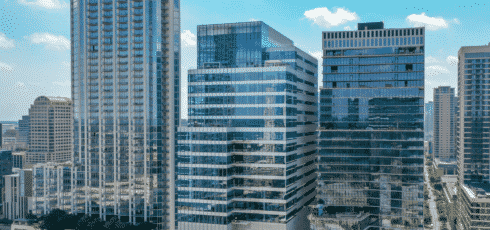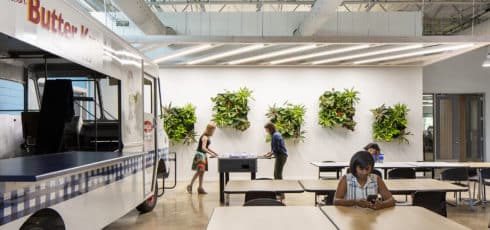This article was originally published in AQUILA’s 2Q 2022 Austin Office Market Report.
In its 2018 end-of-year summary, CREtech reported that $9.6 billion had been invested in real estate-related tech that year, down slightly from 2017 but still impressive for an industry generally considered slow to adopt change.1 While we are familiar with many of the research and ownership-focused technologies on the market today like CoStar and View the Space, we began to wonder if new technology has started to find its way into the development and operation of buildings themselves.
Read Now: How Office Density Trends Impact Commercial Building Design [Q & A with The Beck Group]
To dig deeper into this topic, we sat down with Brian Miller, Andy Kennedy, Gerard Robinson, and Tom Marsden, architects at The Beck Group, to understand how technology is being implemented in new office developments and tenant build-outs today.
We cover technologies across three categories:
- Sustainability
- Safety & Security
- Workplace
Sustainability
Today, sustainability is at the top of everyone’s mind, not just for the purpose of protecting our environment, but to cut costs and increase profitability as well. In a city like Austin, where property taxes are increasingly driving up operating expenses (“opex”) in commercial buildings, property owners are having to find ways to decrease opex in other areas to keep their buildings competitive.
The LEED certification program, run by the U.S. Green Building Council, is the most well-known way commercial buildings have been promoting sustainability in recent years. AQUILA has written previously on LEED certification and the impact it has on rental rates, but we wondered if achieving some level of LEED certification has become so common in Austin that it is now the standard rather than a differentiator.
Q: Is achieving LEED Certification still the goal of many developers trying to build an efficient building, or are there other initiatives that have become more common?
TOM: LEED certification is not the standard in most cases, it is more of a byproduct of initiatives already being undertaken by developers to improve the efficiency of their buildings. Developers are recognizing the benefits of higher efficiencies within the building, and if they are planning to hold onto the building for an extended period, they can see those economic benefits add up over time.

ANDY: The main success of LEED is that it made sustainability a marketable attribute of a building, but now that energy codes have become more strict and the overall idea of sustainability has become more commonplace I would say it has become less of a goal for developers. I think we will see more developers aim to attain WELL certification moving forward. Whereas LEED is focused on a building’s efficiency, WELL is focused on improving the health and wellness of the people within the building.
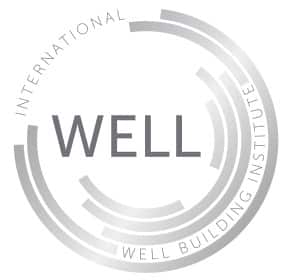
Achieving either certification, of course, requires the developer to implement new and better building systems to create efficiencies that more outdated systems wouldn’t be able to accomplish. There are countless areas where improvements are being made, but four key areas of innovation stand out: glass, HVAC systems, water, and lighting.
Read Next: How Does LEED Certification Impact Austin Office Rental Rates?
Q: How are office developers addressing the issue of sustainability with new technologies and systems?
BRIAN: In a typical office building in Austin today, the clients and tenant reps usually want floor-to-ceiling glass all the way around the building, requiring the glass to be a critical piece in contributing to the building’s energy goals. We are seeing more and more new innovations in glass coatings and design to drive the performance of these windows and make them more efficient. The use of double low-e coatings (which reduce the amount of ultraviolet and infrared light passing through the glass) continues to emerge, and I think we’ll see even more triple-glazed insulated units in the future.
The amount and type of glass not only has an impact on the volume of light entering the building and the views tenants can have from their spaces but also influences the building’s ability to maintain a constant temperature. Because of this, a building’s HVAC system needs to be both efficient and robust, especially in office buildings where glass makes up the majority of the outside walls.
BRIAN: As far as HVAC, in Austin, we are starting to see the use of variable refrigerant flow (VRF) systems. Other markets have been a little ahead of Austin in using these, but we are starting to see clients here adopting these systems in the last year to year and a half. They offer higher efficiency in terms of energy use, as well as being a more compact system. This is appealing because it takes up less space in the ceiling, which means it becomes possible to do higher ceilings or even add an additional floor in some cases.
TOM: VRF is also a part of the WELL Building initiative because it allows more control over specific zones within a tenant’s space so you can control the temperature in more specific areas. The systems might be more expensive for the developer up front, but if they hold the building, then it can be much less expensive to operate in the long run.
According to the General Services Administration, a VRF system can reduce HVAC energy costs by 30% or more, meaning a more efficient building and lower opex costs.2 It is a little surprising that Austin has been slow to adopt this type of HVAC system (especially since we are no strangers to a few 100+ degree days during the summer), but as contractors become more accustomed to installing them we should start seeing more developments using VRF.
Read Next: HVAC Preventative Maintenance Checklist for Commercial Buildings (5 Steps)
Water is another key aspect of an office building that can have a major influence on its efficiency and the impact it has on the environment. Luckily, Beck has experience with a new water system being used in the RiverSouth development and had great insight into what this new system could mean moving forward.
GERARD: For the RiverSouth project that we are designing and building, we are tying into Austin’s “purple pipe” water system, which is the City’s system for reclaiming wastewater and putting it to use. In office buildings, most of the water use results in wastewater, so it makes a lot of sense for an office building to have a system like this. We are also recapturing the condensate from the mechanical systems along with rainwater to provide an additional offset to the building’s water use. Although the reclaimed water can’t be used for drinking, it can be used for things like irrigation. The City’s goal with the “purple pipe” system is to conserve and reuse water where possible, and that’s what we plan to accomplish at RiverSouth.
Although most occupants in an office building won’t notice a “behind the scenes” improvement like the type of water system a building is utilizing, there is one area of changing technology that you can’t help but see: lights.
TOM: Lights themselves are becoming smarter. They have sensors in them, can be self-adjusting, and can automatically dim themselves to adjust for the amount of daylight. I expect we will start to see a ton of spaces using these and it will add up to a lot of energy savings. There are also organic light-emitting diode (OLED) light panels that are coming too, which are super thin, bendable, and allow you to use less power than LED lights. LG has just launched a line of these panels, so I think that’s something we will start seeing be put into both tenant spaces and shared spaces like lobbies since they offer so much opportunity for customization. We aren’t seeing it being specified yet, but I’ve been asking about it for 10 years, so I’m glad to see it’s almost here!
Clearly, sustainability and efficiency are at the top of mind for many developers, and technologies are quickly following behind to help address those concerns. Any Austinite who has looked towards downtown recently knows that many more large, glass office towers are on the way, so it will be interesting to see how the efficiency of those buildings continues to improve.
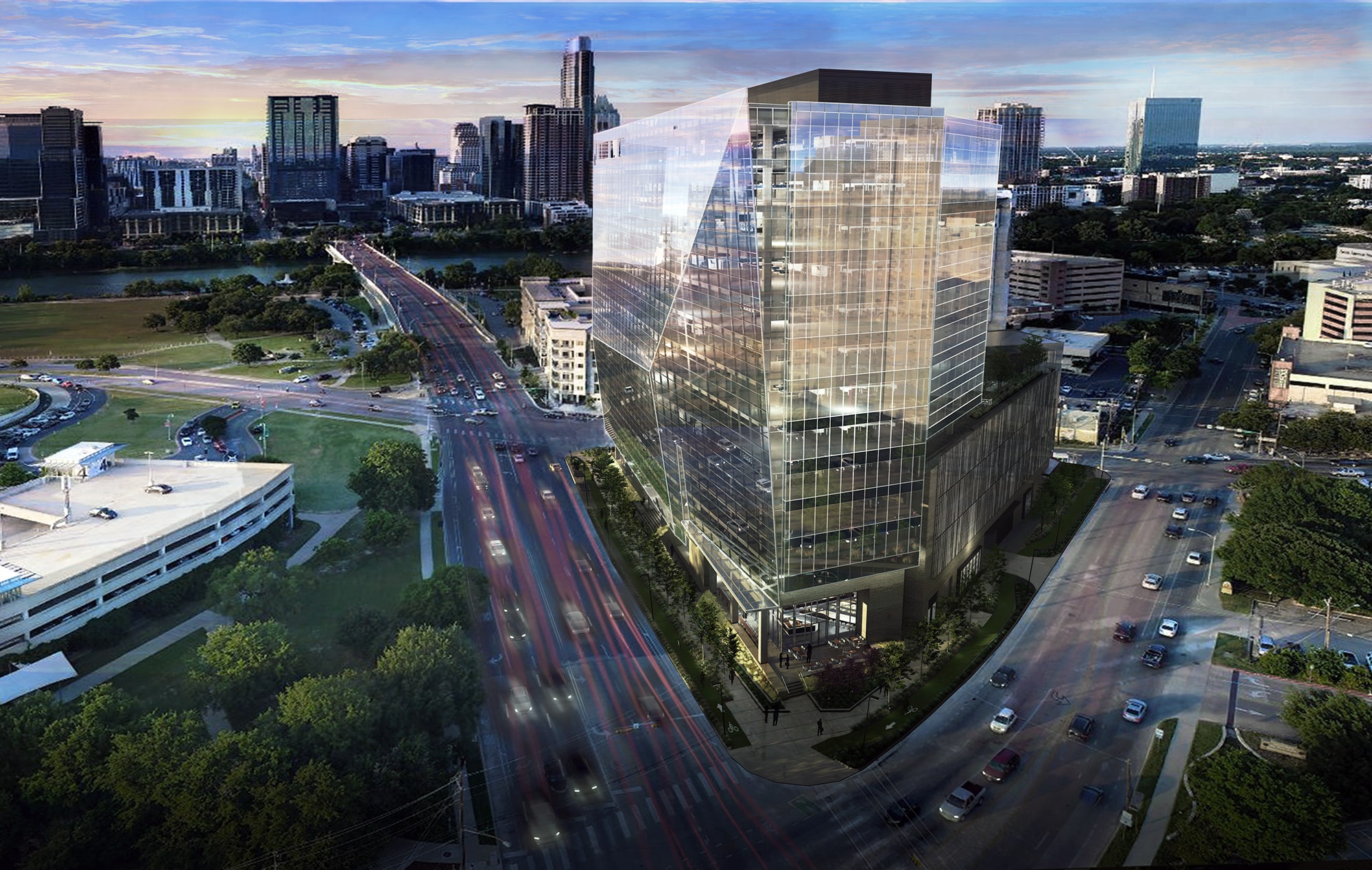
Pictured: A rendering of RiverSouth. (Photo courtesy of The Beck Group)
Safety & Security
Providing a safe and secure work environment is almost a given in most professional workplaces today, and office buildings in Austin are no exception. However, an important aspect of safety and security is being prepared for the unexpected, and that’s where we were interested to see how developers and building owners are navigating this issue through technology.
Q: Are you seeing developers and building owners go beyond the usual security guard and lobby cameras to provide a safer, more secure environment for tenants? If so, what are they doing to provide this improved sense of security?
TOM: A few buildings have started to no longer use security guards, but for now most tenants and building owners still want the physical presence of a security guard on top of the security technology that’s available. However, I think the integration of technology with a physical security guard is something we will start seeing more and more of.
BRIAN: Today we are seeing camera technologies like recognizing a car entering or exiting a garage, and you can imagine that eventually, facial recognition would get to a similar point where you could alleviate the need for key fobs and use someone’s face to grant them access to a building or suite. The building would essentially be able to recognize not only that you are supposed to be there, but what you are likely to be doing. It could know to take you to the correct floor, perhaps, which we are already starting to get a taste of with products like Destination Dispatch, which is being used in some elevator systems today. Destination Dispatch allows the elevator system to “know” that you work on the 34th floor and take you there, without you needing to physically interact with anyone or anything to get there.
With that said, physical safety is not the only security concern we have to think about in our modern world; cyber security has now become another major consideration that can’t be ignored. A company’s data and confidential information can be valuable parts of its business, so protecting those assets is top of mind for many tenants.
Q: Have you seen any tenants or developers taking steps to improve cyber security?
ANDY: We’re seeing lots of redundancy being built into systems. It’s not that new of an idea, but we are seeing steps like having two different data suppliers coming into two different locations from two different closets. That way when a business is completely dependent on these systems working, you have redundancy in case something fails.
BRIAN: As buildings become more integrated with technologies like facial recognition, the systems in the background operating those things could obviously be vulnerable to some kind of cyber attack. So the question really becomes, “How do you protect your building from being hacked?” That’s a question we aren’t really seeing being answered at the building level right now, but tenants are having to answer it for their own spaces and data, and the capabilities being designed that are required to house and handle that data.
So, while we likely won’t see the role of a security guard replaced any time soon, we might begin to see additional security concerns arising, and being addressed, through the use of technology.
Workplace
But it’s not just technologies being used to improve the operation of the building that are making their way into developments, a few are meant to make working in the building more enjoyable as well.
JLL, for instance, recently announced JiLL, an AI-based assistant used to schedule meetings, reserve conference rooms, and more (think Amazon Alexa but for the workplace), and the developers of Davenport 360 in Northwest Austin have added “smart” windows that can be tinted on demand so employees can enjoy the view without needing to close the blinds when the Texas sun starts to heat up.
While these pieces of tech were the ones that made headlines, we wondered what other tech we might start seeing in the future.

Pictured: A rendering of Davenport 360. The building will have “smart” windows that can be tinted on demand so employees can enjoy the view without needing to close the blinds. (Photo from CoStar)
Q: What are some new technologies coming down the pipeline that will be beneficial to a building’s occupants, and how are developers planning ahead to accommodate those technologies?
TOM: I think the next big thing that’s coming is 5G and the impact it will have on buildings. With 5G, the idea of a “smart building” will really start to become possible. It’s a little bit like rolling out the internet, where it was great to have but nobody really knew what to do with it. Once it developed and people started to realize all the cool things it could do, it started to get bigger and bigger. I think 5G is similar. The signal will be much faster, but it requires a lot more network. We haven’t dealt with this on a building yet, but I think any building we are currently working on it’s important to be thinking about this and preparing for it because retrofitting later is a challenge.
BRIAN: We’re definitely putting electric car chargers in buildings today and they have generally become a standard. I think it’s going to be interesting as it moves from a novelty to more of a sizable portion of the vehicles on the road. When that happens, we’ll have to start deciding what type of accommodation should be made. It’s easy to add a handful of charging stations to a building, but when the volume of electric vehicles begins to rise, are we going to continue to offer those same accommodations? In my mind that is unknown territory.
To learn more about the rapid changes in Austin’s office market, download our latest market report.

Q: What is the most interesting trend you are starting to see in office developments that you think will be further impacted and enhanced as technologies improve?
TOM: I think the activation of the spaces in and around buildings is something we are seeing more of. Things like putting interactive elements into lobbies and basically changing the lobby from how it has been traditionally seen as a place you quickly walk through on your way to somewhere else and turning it into a place that becomes the destination where people will spend time.
Beck is currently building the AT&T Innovation District in Dallas, and the idea is trying to activate the area surrounding it where you aren’t just providing a great place for the employees, but creating a benefit for the surrounding area as well. That kind of thing is going to be happening more and more, where digital and physical experiences start coming together to make spaces feel lived in rather than just feeling like another big building.
Conclusion
With technology changing every day, and the needs of tenants rapidly evolving with it, it’s hard to say what the office environment will look like in the future. However, we can see that technology is becoming increasingly important (and expected) as part of the office experience and plays a vital role in keeping the modern office building running smoothly. If the differences between the typical office environment today and the average environment of yesteryear is anything to go off of, we are excited to see how office space continues to be increasingly more sustainable, safe and enjoyable.
If you’re looking to upgrade your existing or future office, you should consider hiring a project manager to ensure you have all the updated technologies that you want. To learn more, download our Ultimate Guide to Hiring a Project Manager for Your Office Build-Out.
1Source: CREtech – 2018 End-Year Report
2Source: General Services Administration – Variable Refrigerant Flow Systems




